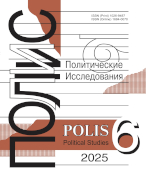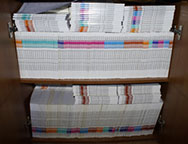Online interaction of municipal authorities with the population (case of surveys on VKontakte in the Northwestern federal district of Russia)
Prokopiev E.A.,
Institute of Economics Karelian Research Center RAS, Petrozavodsk, Russia, e_prokopiev@mail.ru
elibrary_id: 624085 | ORCID: 0000-0002-3350-3726 | RESEARCHER_ID: J-4683-2018
Kurilo A.E.,
Doctor of Economics, Institute of Economics Karelian Research Center RAS, Petrozavodsk, Russia, akurilo@mail.ru
elibrary_id: 110520 | ORCID: 0000-0002-7222-7832 | RESEARCHER_ID: S-7213-2019
Shlapeko E.A.,
Institute of Economics Karelian Research Center RAS, Petrozavodsk, Russia, shlapeko_kate@mail.ru
elibrary_id: 722398 | ORCID: 0000-0003-3518-4543 | RESEARCHER_ID: L-8234-2017
Gubina O.V.,
Institute of Economics Karelian Research Center RAS, Petrozavodsk, Russia; N. Laverov Federal Center for Integrated Arctic Research, Ural Branch of the Russian Academy of Sciences, Arkhangelsk, Russia , welcomeforyou@yandex.ru
elibrary_id: 168084 | ORCID: 0000-0002-3678-3911 | RESEARCHER_ID: W-2104-2017
Article received: 2024.05.06 14:36. Accepted: 2024.12.28 14:37

DOI: 10.17976/jpps/2025.03.10
EDN: RXQMHW
Prokopiev E.A., Kurilo A.E., Shlapeko E.A., Gubina O.V. Online interaction of municipal authorities with the population (case of surveys on VKontakte in the Northwestern federal district of Russia). – Polis. Political Studies. 2025. No. 3. https://doi.org/10.17976/jpps/2025.03.10. EDN: RXQMHW (In Russ.)
The study was funded by the grant of the Russian Science Foundation №23-28-00685 “Digital divide gap and local governments: social media review”. https://rscf.ru/project/23-28-00685/.
The extensive and compulsory adoption of social media by government authorities facilitates citizens’ participation in the decision-making process. Therefore, it seems relevant to study the nature and topics of communication of Russian municipal authorities with local communities within the social landscape. Based on the text data analysis, the article examines the regional features of organizing population surveys on the official pages of the Northwestern Federal District municipalities on VKontakte. The research consisted of several stages: 1) formation of a database on municipal official pages in VK; 2) automated collection of surveys; 3) classification of surveys by content and time; 4) determination of interregional differences and similarities in conducting surveys. 2536 surveys from the official pages of municipal districts and 1321 surveys from the official pages of municipalities were analyzed. Surveys on the official pages of regional and local authorities are conducted in social, economic, political and entertainment areas. There is a positive trend with the increase of surveys on VK in the regions of the Northwestern Federal District. The entertainment sphere predominates in groups of districts; whereas the social sphere predominates in settlements. Data analysis showed that surveys are conducted in settlements’ groups in order to solve specific territorial problems in comparison to groups of districts. The questions about the future prevail at the settlement level that can be explained by the development of participatory budgeting. The example of regional brand surveys showed that it is not only a convenient way of communication with the population, but also an opportunity to find out the residents’ opinions and get approval for changes. Surveys conducted on government official pages can serve as a crowdsourcing tool to enhance public engagement in municipal affairs.
References
Bozkanat, E. (2020). Municipal engagement on Facebook*7 in Turkey. İlef Dergisi, 7(2), 247-268. https://doi.org/10.24955/ilef.822773
DePaula, N., & Dincelli, E. (2018). Information strategies and affective reactions: how citizens interact with government social media content. First Monday, 23(4). https://doi.org/10.5210/fm.v23i4.8414
Dias, G.P. (2022). Local governments on Facebook*: what content encourages citizen participation and what type of municipalities post it the most? In 15th International Conference on Theory and Practice of Electronic Governance (ICEGOV 2022), October 04-07, 2022, Guimarães, Portugal. ACM, New York (pp. 242-250). https://doi.org/10.1145/3560107.3560147
Florek, M. (2011). Online city branding. In K. Dinnie (Ed.), City Branding. London: Palgrave Macmillan. https://doi.org/10.1057/9780230294790_10
Gökalp, B., Karkın, N., & Calhan, H. S. (2023). The political use of social networking sites in Turkey: a systematic literature analysis. In I. Management Association (Ed.), Research Anthology on Social Media’s Influence on Government, Politics, and Social Movements (pp. 565-584). https://doi.org/10.4018/978-1-6684-7472-3.ch027
Guillamón, M.-D., Ríos, A.-M., Gesuele, B., & Metallo, C. (2016). Factors influencing social media use in local governments: the case of Italy and Spain. Government Information Quarterly, 33(3), 460-471.https://doi.org/10.1016/j.giq.2016.06.005
Kavaratzis, M. (2012). From “necessary evil” to necessity: stakeholders’ involvement in place branding. Journal of Place Management and Development, 5, 7-19.
Lappas, G., Triantafillidou, A., & Kani, A. (2022). Harnessing the power of dialogue: examining the impact of Facebook* content on citizens’ engagement. Local Government Studies, 48(1), 87-106. https://doi.org/10.1080/03003930.2020.1870958
Loukis, E.N. (2018). Citizen-sourcing for public policy making: theoretical foundations, methods and evaluation. In J. Gil-Garcia, T. Pardo, L. Luna-Reyes (Eds.), Policy Analytics, Modelling, and Informatics. Public Administration and Information Technology, 25. Cham: Springer. https://doi.org/10.1007/978-3-319-61762-6_8
Lovari, A., & Parisi, L. (2015). Listening to digital publics. Investigating citizens’ voices and engage ment within Italian municipalities’ Facebook* pages. Public Relations Review, 41(2), 205-213. https://doi.org/10.1016/j.pubrev.2014.11.013
Mainka, A., Hartmann, S., Stock, W.G., & Peters, I. (2015). Looking for friends and followers: a global investigation of governmental social media use. Transforming Government: People, Process and Policy, 9(2), 237-254. http://dx.doi.org/10.1108/TG-09-2014-0041
Marpaung, Z., & Santoso, A. (2020). YouTube adoption: promoting local government transparency? In Proceedings of the Annual Conference of Indonesian Association for Public Administration (IAPA2019). Advances in Economics, Business and Management Research, Atlantis Press, 1-20. https://doi.org/10.2991/aebmr.k.200301.001
Mergel, I. (2013). Social media adoption and resulting tactics in the U.S. federal government. Government Information Quarterly, 30(2), 123-130. https://doi.org/10.1016/j.giq.2012.12.004
Mitaľ, O. (2020). The use of social media in public administration: the case of Slovak local self-government. Halduskultuur: The Estonian Journal of Administrative Culture and Digital Governance, 21(1), 56-75.
Moghaddam, E.N., Aliahmadi, A., Bagherzadeh, M., Markovic, S., Micevski, M., & Saghafi, F. (2023). Let me choose what I want: The influence of incentive choice flexibility on the quality of crowdsourcing solutions to innovation problems, Technovation, 120 (102679). https://doi.org/10.1016/j.technovation.2022.102679
Muñiz, С., Campos-Domínguez, E., Saldierna, A.R., & Dader, J. L. (2019). Engagement of politicians and citizens in the cyber campaign on Facebook*: a comparative analysis between Mexico and Spain. Contemporary Social Science, 14(1), 102-113.
Oliveira, G.H.M., & Welch, E.W. (2013). Social media use in local government: linkage of technology, task, and organizational context. Government Information Quarterly, 30(4), 397-405. https://doi.org/10.1016/j.giq.2013.05.019
Reddick, C.G., Chatfield, A.T., & Ojo, A. (2017). A social media text analytics framework for double-loop learning for citizen-centric public services: A case study of a local government Facebook* use. Government Information Quarterly, 34(1), 110-125. https://doi.org/10.1016/j.giq.2016.11.001
O’Reilly, T. (2007). What is web 2.0: design patterns and business models for the next generation of software. Communications & Strategies, 1, 17-37. https://www.oreilly.com/pub/a/web2/archive/what-is-web-20.html
Rodríguez, M. P. (2017). Governance models for the delivery of public services through the web 2.0 technologies: a political view in large Spanish municipalities. Social Science Computer Review, 32(2), 203-225. https://doi.org/10.1177/0894439315609919
Filatova, O.G. (2020). Heads of Russian regions in social media: audit of public communications. PR and Advertising in a Changing World: Regional Aspect, 23, 6-16. (In Russ.)
Fokin, I.A. (2021). Crowdsourcing as a tool for citizens ‘involvement and participation in public policy: experience of Russian regions (2015-2021). Business. Society. Power, 2, 85-119. (In Russ.)
Kharitonova, O.V., & Bugaeva, T.N. (2020). Crowdsource in state and municipal administration: essence and prospects of use. Bulletin of Eurasian Science, 2. (In Russ.) https://esj.today/PDF/91ECVN220.pdf
Kolesnik, N.V., Kornienko, A.V., & Khosueva, S.D. (2022). Political socialization, social networks and communications: the directions of research. Petersburg Sociology Today, 18, 86-100. (In Russ.) https://doi.org/10.25990/socinstras.pss-18.1j02-j832
Lektorova Ju.Iu., Prudnikov A.Iu., Pleshkova A.V. (2022). Government crowd sourcing as a technology for territorial development and an image resource of power. Ars Administrandi, 14(4), 624-645. (In Russ.) https://doi.org/10.17072/2218-9173-2022-4-624-645
Mikhaylova, A.A. (2022). Intermunicipal differences in the digital susceptibility of the population. Monitoring of Public Opinion: Economic and Social Changes, 4, 222-246. (In Russ.) https://doi.org/10.14515/monitoring.2022.4.2006
Nikitenkova M.A. (2019). American governance practice approach: crowdsourcing as a platform for public policy transition to the internet space. Eurasian Scientific Association, 12-3, 250-253. (In Russ.)
Shchekotin, E.V., Myagkov, M.G., Goiko, V.L., Kashpur, V.V., & Kovarzh, G.Yu. (2020). Subjective measurement of population ill-being/well-being in the Russian regions based on social media data. Monitoring of Public Opinion: Economic and Social Changes, 1, 78-116. (In Russ.) https://doi.org/10.14515/monitoring.2020.1.05
Sokolov, A.V., & Isaeva, E.A. (2022). Transforming the interaction between authorities and civil society in digital: the evidence from the Yaroslavl region. RUDN Journal of Political Science, 24(4), 686-710. (In Russ.) https://doi.org/10.22363/2313-1438-2022-24-4-686-710
Vasilenko, L.A., Zotov, V.V., & Zakharova, S.A. (2020). Social media potential for developing participatory governance. RUDN Journal of Sociology. 20(4), 864-876. (In Russ.) https://doi.org/10.22363/2313-2272-2020-20-4-864-876
Vizgalov, D.V. (2011). Brending goroda [City branding]. Moscow: Institute of Urban Economics Foundation. (In Russ.)
See also:
Stukal D.K., Shilina A.N.,
Attitudes toward authorities as a factor of the political trolling perception on social media in Russia. – Polis. Political Studies. 2022. No4
Litvinova T.N.,
The Effectiveness of Regional Power: from Theory to Measurement (Case Study of the North Caucasus Federal District Republics). – Polis. Political Studies. 2020. No2
Köchler H.,
The new social media: chance or challenge for dialogue?. – Polis. Political Studies. 2013. No4
Akhremenko A.S., Stukal D.K., Petrov A.P.,
Network vs Message in Protest Diffusion on Social Media: Theoretical and Data Analytics Perspectives. – Polis. Political Studies. 2020. No2
Timofeyeva L.N., Ryabchenko N.A., Malysheva O.P., Gnedash A.A.,
The digital socio-political agenda and its conceptualization within the new media ecology framework. – Polis. Political Studies. 2022. No2




.jpg)






 print
print
.jpg)
.jpg)